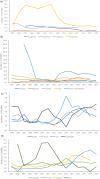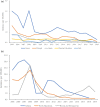Long ignored but making a comeback: a worldwide epidemiological evolution of human brucellosis
- PMID: 38039063
- PMCID: PMC10878345
- DOI: 10.1080/22221751.2023.2290839
Long ignored but making a comeback: a worldwide epidemiological evolution of human brucellosis
Abstract
Brucellosis is a commonly neglected zoonosis that remains a serious global public health concern. The epidemiological evolution of human brucellosis has considerably changed over the past few decades, and epidemic geography is continuously expanding. Human brucellosis is emerging and re-emerging, and is imported from areas where it is endemic due to travel, immigration, and international trade. The disease continues to be prevalent in Asia and Africa, including West Asia, Central Asia, North Africa, and East Africa, with the highest incidence in Syria, Kyrgyzstan, Mongolia, Iran, Algeria, and Kenya. Re-emerging cases are frequently recorded in places where brucellosis has been controlled, such as Bosnia, Herzegovina, Azerbaijan, and the USA. In countries with a high disease burden, disease control and eradication have been extremely difficult because of livestock farming being the only source of livelihood, unique religious beliefs regarding animals, nomadic lifestyle, and low socioeconomic levels. Interventions focused on protecting livestock keepers are needed, particularly for those assisting with goat and sheep births and the consumption of raw dairy products. Notably, in most countries with a high disease burden, each period of several years with a low incidence rate was followed by a subsequent increase in cases, highlighting the necessity of continuous investment and surveillance. In addition, advocacy for the inclusion of brucellosis as a globally mandated reported disease, strict restrictions on animal movement, mandated consumption of pasteurized milk, and health education are needed. This study will help form an evidence-based strategy for international organizations to curb the future spread of brucellosis.
Keywords: Human brucellosis; cases; epidemiological evolution; incidence rate; seropositive.
Conflict of interest statement
No potential conflict of interest was reported by the author(s).
Figures





Similar articles
-
Ruminant brucellosis in the Kafr El Sheikh Governorate of the Nile Delta, Egypt: prevalence of a neglected zoonosis.PLoS Negl Trop Dis. 2011 Jan 11;5(1):e944. doi: 10.1371/journal.pntd.0000944. PLoS Negl Trop Dis. 2011. PMID: 21264355 Free PMC article.
-
Caprine brucellosis: A historically neglected disease with significant impact on public health.PLoS Negl Trop Dis. 2017 Aug 17;11(8):e0005692. doi: 10.1371/journal.pntd.0005692. eCollection 2017 Aug. PLoS Negl Trop Dis. 2017. PMID: 28817647 Free PMC article. Review.
-
Brucellosis is a public health problem in southern Italy: Burden and epidemiological trend of human and animal disease.J Infect Public Health. 2018 Nov-Dec;11(6):861-866. doi: 10.1016/j.jiph.2018.07.007. Epub 2018 Jul 25. J Infect Public Health. 2018. PMID: 30056067
-
Brucellosis: Prevalence with reference to East African community countries - A rapid review.Vet Med Sci. 2021 May;7(3):851-867. doi: 10.1002/vms3.425. Epub 2021 Jan 9. Vet Med Sci. 2021. PMID: 33421354 Free PMC article. Review.
-
Human Brucellosis in Greece, 2005-2020: A Persistent Public Health Problem.Vector Borne Zoonotic Dis. 2022 Mar;22(3):163-169. doi: 10.1089/vbz.2021.0050. Vector Borne Zoonotic Dis. 2022. PMID: 35319918 Review.
Cited by
-
Motor polyradiculoneuropathy as an unusual presentation of neurobrucellosis: a case report and literature review.BMC Infect Dis. 2024 May 14;24(1):491. doi: 10.1186/s12879-024-09365-2. BMC Infect Dis. 2024. PMID: 38745172 Free PMC article. Review.
-
Spatiotemporal distribution and ecological factors of disease burden in Inner Mongolia's working age population with brucellosis from 2015 to 2020.Sci Rep. 2025 Apr 18;15(1):13496. doi: 10.1038/s41598-025-96464-y. Sci Rep. 2025. PMID: 40251217 Free PMC article.
-
Development of a plant-based vaccine against brucellosis: stable expression of Brucella abortus OMP25 in transgenic tobacco.Transgenic Res. 2025 Apr 29;34(1):22. doi: 10.1007/s11248-025-00441-0. Transgenic Res. 2025. PMID: 40299164 Free PMC article.
-
Epidemiological spectrum of infectious uveitis in the Asia-Pacific.Taiwan J Ophthalmol. 2025 Jun 10;15(2):157-181. doi: 10.4103/tjo.TJO-D-25-00052. eCollection 2025 Apr-Jun. Taiwan J Ophthalmol. 2025. PMID: 40584206 Free PMC article. Review.
-
Analysis of the Brucella melitensis epidemic in Xinjiang: genotyping, polymorphism, antibiotic resistance and tracing.Ann Clin Microbiol Antimicrob. 2024 Aug 10;23(1):71. doi: 10.1186/s12941-024-00724-0. Ann Clin Microbiol Antimicrob. 2024. PMID: 39127671 Free PMC article.
References
Publication types
MeSH terms
LinkOut - more resources
Full Text Sources
Other Literature Sources
Miscellaneous
